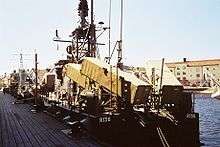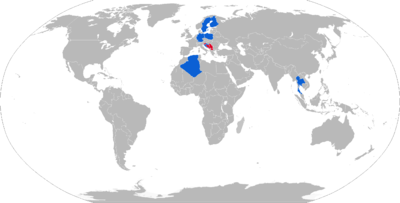RBS-15
| RBS-15 | |
|---|---|
|
RBS-15 on right | |
| Type |
Fire-and-forget anti-ship and land attack |
| Place of origin | Sweden |
| Service history | |
| In service | 1985–present |
| Used by | See operators |
| Production history | |
| Manufacturer | Saab Bofors Dynamics, Diehl BGT Defence |
| Specifications | |
| Weight | 800 kg |
| Length | 4.33 m |
| Diameter | 50 cm |
| Warhead | 200 kg HE blast and pre-fragmented warhead. |
Detonation mechanism | impact or proximity |
|
| |
| Engine | turbojet |
| Wingspan | 1.4 m |
Operational range |
70 km for RBS-15 Mk. I and II 250 km for RBS-15 Mk. III |
| Flight altitude | sea skimming |
| Speed | subsonic |
Guidance system | inertial, GPS, terminal active radar homing (J band) |
Launch platform | naval ships, aircraft and land-based missile launchers |
The RBS-15 (Robotsystem 15) is a long-range fire-and-forget surface-to-surface and air-to-surface, anti-ship missile. The later version Mk. III has the ability to attack land targets as well. The missile was developed by the Swedish company Saab Bofors Dynamics.
History
The Swedish Navy pioneered anti-ship missiles with the Halland-class destroyers using the RB08 missile since the early 1960s. The main effect of he Defence decision of 1958 for the Navy was restructuring into a lighter force consisting of fast attack craft (FAC) vessels and a halt to destroyer procurement. This posed a problem as the existing RB08 missile required launch rails and a missile magazine in the destroyers, taking up space that was not there on smaller ships. Adding to the problems, each missile had to be individually prepared for launch and only two missiles could be on the launch rails at the same time. In comparison, the P-15 Termit (NATO codename Styx) missile used by the Soviet Union (which was the expected adversary) stored the missiles in individual containers on deck which left the missiles immediately available for launch. Tests were carried out on Plejad class FACs with a single bow-mounted RB08 in the late 1960s, but they came to nothing.
Saab's next attempt at anti-ship missiles to equip the Norrköping class FACs of the Swedish navy was in 1978 under the project name "RB 04 Turbo", a development of the air force RB 04E missile with a turbofan engine, changed wing configuration and start rockets to take off from land. The initial proposal was rejected as inferior to the Harpoon. The project, under the leadership of Hans Ahlinder, then worked out a proposal for a missile with greater capabilities and superior performance to the Harpoon. To indicate that it was a new weapon the project name was changed from "RB 04 Turbo" to "RBS-15".[1]

The first weapon contract was signed in 1979; at the last minute the Swedish government did not buy the Harpoon anti-ship missile, opting for an indigenous design. The first missiles were delivered to the Navy in June 1984, and the ship version RBS-15 Mk. I was introduced.

The Swedish Navy ordered the missile in 1984 to develop a coastal defense version of the RBS-15F. The missile was taken into Swedish Navy service as the Rb 15 by the Swedish Navy and became operational in 1985. The Swedish Air Force received their missiles a couple of years later. The Mk. I was produced from 1985 to 1990.
Work on a further developed version, the RBS-15 Mk. II, began in the early 1980s. But it took until 1994 to get a development contract for the upgraded anti-ship missile. The Mk. II has the same range (70+ km), but the mid-course and terminal guidance system, as well as the radar and IR signature were upgraded. The Mk. II has been produced since 1998.
The development of the RBS-15 Mk. III began in the mid-1990s. It is produced by Saab in co-operation with Diehl BGT Defence of Germany.[2] Emphasis was put on increased range (due to larger fuel capacity and new fuel the range has been increased to some 200 km), improved accuracy (integrated GPS) and selectable priority targeting, which improved the weapon system's flexibility. The Mk. III was selected for the German Navy’s Braunschweig-class corvettes. Finnish truck maker Sisu produces missile launch trucks for RBS-15. The Mk. III has been in production since 2004.
Development phase
The missile was developed from the RB 04 missile that was used by the Swedish air force. The front of the missile was retained, including the warhead, but the rear received new wings and a turbofan engine replaced the rocket previously used. The RBS-15 underwent trials on the missile FAC HMS Piteå from 1983 and became operational with the Swedish Navy in 1985. The Västergötland class submarines were to have 4 vertical missile launch tubes for RBS-15 missiles in an extended hull, canceled due to budget constraints and to not fitting the way Swedish submarines operated.
Replacement
In March 2017 Saab received an order for a new generation anti-ship missile to replace the RBS-15. The order is valued at 3.2 billion SEK and deliveries will take place between 2017–26. The new missile will have better range, a better seeker and lower weight. It will have the ability to knock out a wide range of sea and land targets, all-weather capability and a design that allows for future upgrades.[3]
Versions
- RBS-15 Mk. I
- Powered by a French Microturbo TRI-60 engine, with a thrust of 3.73 kN (380 khp/830 lbf). Range 70+ km
- RBS-15F
- An Mk. I adapted for air launch. Entered service in 1989.
- RBS-15 Mk. II
- Range 70+ km. Designed to be launched from a number of different platforms, such as land-based launchers, aircraft, and ships.
- RBS-15SF
- Mk. II version for Finland. Local designation MTO 85 (Meritorjuntaohjus 1985)
- RBS-15 Mk. III
- Range over 200 km, with land attack capability.[4] New warhead (increased penetration and insensitive munitions qualification) from TDW. There is only a ship launched version. Production started in 2004. New oval launch tubes instead of the old box type.[5]
- RBS-15F ER
- Aircraft launched version of the Mk. III
- RBS-15SF-3
- Both new Mk. IIIs and upgraded Mk. IIs, which have been upgraded to Mk. III standard. Finnish designation MTO 85M
- RB-15 Mk. III+ & RB 15 F-ER
- Ordered in March 2017 by Sweden. Will have better range, a better seeker and lower weight. It will have the ability to knock out a wide range of sea and land targets, all-weather capability and a design that allows for future upgrades. To be carried by Visby-class corvettes and JAS Gripen E. Will be delivered between 2017-2026 and fully operational in the mid 2020s.[6][7]
Operators

Current operators


The RBS-15 Mk. III will equip the two MEKO 200 frigates under construction for the Algerian National Navy. Delivery is scheduled for 2015–16.[8][9][10]
Primary weapon of the Croatian Navy for its five guided missile corvettes and three coastal systems mounted on Tatra trucks. In total, 48 Mk.I units are in service. Plans for upgrading 21 missiles to a standard incorporating elements from both the Mk.II and the Mk.III versions was cancelled in 2009 due to budget restraints but light software upgrades were continuously executed and have improved the missiles' navigation, precision and electronic defence. The latest of this upgrades was conducted in 2010 as part of usual service works. Unexpectedly though, in August 2014 the Croatian government decided to send at least 20 Croatian RBS-15 missiles through an overhaul program so as to keep them operational and current for another 10 years. The missiles are to receive upgrades to increase their range to about 90–100 km as well as to improve their guidance, precision and survivability against jamming. The missiles were successfully launched and destroyed their targets in live fire naval exercises in 2015 amd 2016.
The Finnish Navy operates RBS-15SF-III (Mk. IIs, designation MTO 85) that have undergone various upgrades during their lifetime. The missiles are carried by the Hamina class missile boat and the Rauma class missile boat. Finland also operates the missiles from Sisu trucks for mobile coastal defense.[11][12]
The German Navy has chosen the Mk. III to equip its Braunschweig class corvettes.
The Polish Navy has chosen the Mk. III to equip its Orkan class fast attack craft. It signed a deal worth €110 million and Thales Naval Netherlands will modify the Orkan class ships. Mk.II missiles for Navy mobile land based launchers have also been delivered as part of the offset deal.
The Swedish Navy operates the missiles from its Stockholm, Göteborg and Visby class corvettes. The Swedish coastal artillery was also equipped with RBS-15Ms, which were mounted on Scania trucks. Four missile batteries were planned,[13] but in the end only one battery was ever ordered serving from 1995 to 2000 when the coastal artillery was disbanded. The vehicles in the battery where then scattered.[14] However, in November 2016 it was announced that a secret number of missile trucks had been gathered and reactivated under Navy control.[15][16] The Swedish Air Force operates the RBS-15F. The AJS 37 Viggen and the JAS 39 Gripen carry the missile, with the Viggen no longer in service.
As a part of its Gripen procurement program, the Royal Thai Air Force is to order the air-launch version, the RBS-15F, to equip its Gripen fighter aircraft.[17]
Former operators
Some RBS-15s were delivered during the late 80s for the new Yugoslavian Navy FACs to replace existing Russian-built missiles, but the project was never finalized due to the Croatian War of Independence. Missiles are captured by the Croatian Navy.
See also
- Sea Eagle
- C-802
- Exocet
- SS-N-25
- Harpoon
- Type 80 Air-to-Ship Missile
- Type 88 Surface-to-Ship Missile
- Type 90 Ship-to-Ship Missile
- Type 93 Air-to-Ship Missile
- XASM-3
- Naval Strike Missile
References
- ↑ How the RB 04 Turbo became RBS-15 (in Swedish), Arboga Missile Museum.
- ↑ Diehl Group (5 December 2000). "Alliance Between German Diehl CorporationAnd Swedish SAAB Group On Anti-Ship Missiles". defense-aerospace.com. Briganti et Associés. Retrieved 16 March 2017.
- ↑ http://news.cision.com/se/saab/r/saab-far-bestallning-pa-nasta-generations-sjomalsrobot,c2229060
- ↑ http://www.diehl.com/de/diehl-defence/produkte/lenkflugkoerper/rbs15-mk3.html
- ↑ "RBS15 Mk3 Surface-to-Surface Missile (SSM)". Projects. Naval Technology. 15 June 2011. Retrieved 2013-10-10.
- ↑ http://news.cision.com/se/saab/r/saab-far-bestallning-pa-nasta-generations-sjomalsrobot,c2229060
- ↑ http://www.fmv.se/sv/Nyheter-och-press/Nyheter-fran-FMV/FMV-bestaller-ny-forsvarsmaktsgemensam-sjomalsrobot/
- ↑ Navy recognition.
- ↑ "Algerian Navy ships and equipment". Navy recognition. 25 July 2012. Retrieved 2013-10-10.
- ↑ "Algeria, Thyßen Krupp marine systems", Sea news, TR
- ↑ http://merivoimat.fi/documents/1951215/2015876/MTO-85/81b3196c-26ee-40bd-a79a-f4bd0fe30d67
- ↑ https://corporalfrisk.com/2016/10/18/the-quest-for-mto-xx/
- ↑ GOTLAND RECEIVING NEW EMPHASIS AS ASW, INVASION DEFENSE KEY Dagens Nyheter, 9 May 1987
- ↑ http://navyskipper.blogspot.se/2012/01/var-tog-materielen-vagen-del-1-ka.html
- ↑ "Redeployment to Gotland". SE: SVD. Retrieved 2016-11-19.
- ↑ Sweden Re-introducing Truck-Based RBS15 Coastal Defence Batteries - Navyrecognition.com, 18 November 2016
- ↑ "FMV delivers three Gripen aircraft to Thailand". SE: FMV. Retrieved 2013-10-10.
External links
- RBS15 Mk3 Surface-to-Surface Missile (SSM), Sweden
- Manufacturer's page
- GlobalSecurity.org
- German manufacturer's page (site in English)
- YouTube videoclip of land-based RBS 15
- Flight Global archive, 1973 issue on Anti Ship Missiles
![]() Media related to RBS-15 missiles at Wikimedia Commons
Media related to RBS-15 missiles at Wikimedia Commons